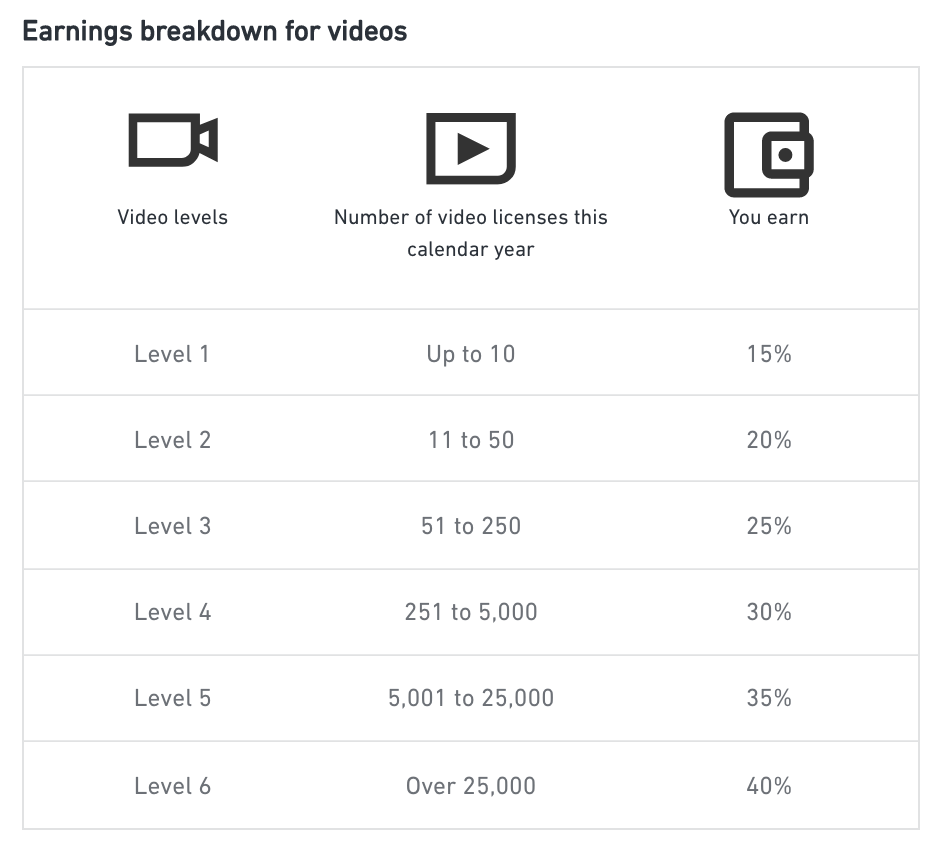Getting your images featured on Shutterstock is a fantastic way to earn passive income and share your creativity with a global audience. But before you jump into uploading, it’s good to understand how the platform works. Shutterstock is a leading stock photo marketplace, and its success relies on high-quality, appealing images that meet specific standards. Whether you’re a seasoned photographer or just starting out with editing skills, knowing the ins and outs of uploading can make all the difference. Let’s walk through the process so you can confidently showcase your work and boost your earnings!
Preparing Your Images for Submission

Before you upload your images to Shutterstock, it’s crucial to prepare them properly. High-quality, well-prepared images not only increase your chances of acceptance but also attract more buyers, leading to higher earnings. Here’s a step-by-step guide to get your images ready:
1. Choose Your Best Shots
Select images that are clear, well-composed, and visually appealing. Focus on images that tell a story or evoke emotion, as these tend to perform well. Avoid overly cluttered or poorly lit photos. Remember, quality always beats quantity!
2. Ensure Technical Quality
- Resolution: Shutterstock recommends a minimum of 4 MP (megapixels), but higher resolution images (like 12 MP or more) are preferred.
- File Format: Save your images in JPEG format with a high-quality setting (preferably 12 or maximum quality).
- Color Mode: Use RGB color mode for digital images.
- Compression: Avoid over-compressing your images, which can degrade quality. Use lossless compression whenever possible.
3. Edit for Perfection
Basic editing can make a big difference. Adjust brightness, contrast, and sharpness to enhance your images. Remove any distracting elements or blemishes. However, avoid over-editing to keep your images natural and authentic.
4. Add Metadata Carefully
Prepare relevant keywords, titles, and descriptions that accurately describe your images. Use descriptive, specific keywords to improve discoverability. Think about what buyers might search for—this boosts your chances of making a sale.
5. Check Shutterstock’s Content Guidelines
Familiarize yourself with Shutterstock’s content policies. Avoid submitting images with copyrighted logos, trademarks, or sensitive content unless you have the necessary rights. Ensuring compliance increases your chances of approval and maintains your reputation as a contributor.
By taking these steps to prepare your images thoughtfully, you set yourself up for success. High-quality, well-tagged images are more likely to get approved and purchased, helping you maximize your earnings on Shutterstock. Happy submitting!
Creating an Account and Setting Up Your Contributor Profile

Alright, so you’re ready to start your journey as a Shutterstock contributor? Great choice! The first step is creating an account and setting up a profile that showcases your work and personality. Think of your profile as your digital storefront—it’s how potential buyers and clients will get to know you, so making it engaging and professional is key.
To get started, head over to the Shutterstock Contributor Portal and click on the “Sign Up” button. You’ll be prompted to fill out some basic information such as your name, email address, and create a password. Make sure to use an email you check regularly — you’ll receive important updates and notifications there.
Setting Up Your Profile
Once your account is created, it’s time to personalize your profile:
- Upload a professional profile picture: A clear, friendly photo helps build trust.
- Write a compelling bio: Share a bit about your background, your photography style, and what kind of images you plan to upload.
- Link your social media or website: If you have a portfolio or social media pages showcasing your work, include links to give buyers more insight into your creative journey.
- Set your payment details: Provide your preferred payout method—PayPal, bank transfer, or others available in your country.
Remember, a well-crafted profile not only increases your credibility but also encourages buyers to browse your portfolio with confidence. Keep your profile updated and showcase your best work to make a strong first impression!
Step-by-Step Process to Upload Images to Shutterstock
Now that your profile is set up, the exciting part begins—uploading your images! Shutterstock has a straightforward upload process, but here are some tips to make it smooth and maximize your earnings.
Step 1: Prepare Your Images
Before uploading, ensure your images meet Shutterstock’s quality standards:
- Resolution: Minimum 4 MP (megapixels), but higher resolution images are preferred.
- File Format: JPEG for photos, AI or EPS for vectors.
- Quality: Sharp, well-exposed, no noise, and properly edited.
- Metadata: Clear, descriptive titles, tags, and captions to help buyers find your images.
Step 2: Log Into Your Contributor Dashboard
Visit the Shutterstock Contributor Portal and log in using your credentials. Once logged in, click on the “Upload” button to start your submission.
Step 3: Upload Your Files
Shutterstock offers multiple upload options:
- Drag and Drop: Easily drag your images into the upload window.
- File Browser: Click to select files from your computer.
For bulk uploads, compress your images into ZIP files if needed, but individual uploads are also fine for smaller batches.
Step 4: Fill Out Metadata
This is a crucial step! Proper metadata helps your images get discovered:
- Title: Be descriptive and specific.
- Tags: Use relevant keywords that buyers might search for.
- Categories: Select the appropriate categories and subcategories.
- Description: Add context or story behind the image if relevant.
Take your time here—good metadata can significantly boost your images’ visibility and sales potential.
Step 5: Submit for Review
Once everything is filled out, click the “Submit” button. Your images will then go through Shutterstock’s review process, which typically takes a few days. During this time, your images are checked for quality, originality, and compliance with Shutterstock’s guidelines.
Step 6: Track Your Submissions and Earnings
After approval, your images go live, and you can start earning. Keep an eye on your dashboard to track downloads, earnings, and pending payments. Regularly uploading fresh, high-quality images will boost your portfolio and earning potential over time.
And that’s it! Uploading images to Shutterstock can be pretty straightforward once you get the hang of the process. Remember, consistency and quality are your best friends here. Happy uploading, and watch those earnings grow!
Tips for Optimizing Your Images for Better Visibility and Earnings
So, you’ve uploaded some stunning images to Shutterstock — great job! But, to really boost your earnings and get your photos noticed by buyers around the world, you need to optimize your images effectively. Think of it as giving your photos a little extra polish so they stand out in a crowded marketplace.
Here are some practical tips to help your images shine:
- Use Clear, Descriptive Titles: Your image titles should accurately describe what’s in the photo. Instead of vague titles like “Beautiful Scene,” go for something specific like “Sunset Over Mountain Lake with Reflection.” Clear titles help buyers find your images when they search for particular subjects.
- Write Detailed Descriptions: Expand on your title with a brief but informative description. Mention the mood, colors, location, or any unique aspects. For example, “A vibrant sunset casting orange and pink hues over a serene mountain lake, perfect for travel or nature-themed projects.”
- Use Relevant Keywords: Keywords are essential for discoverability. Think about what keywords a buyer might use to find your image. Include both broad terms (like “nature,” “sunset”) and specific ones (like “mountain lake,” “reflection,” “orange sky”). Avoid keyword stuffing — be natural and relevant.
- Choose Appropriate Categories: Assign your images to relevant categories to make them easier to find. For instance, a food photo should go under “Food & Drink,” while a business scene fits “Business & Industry.”
- Optimize Image Size and Quality: Upload high-resolution images that are sharp and free of noise. Shutterstock prefers images at least 4MP (megapixels), but larger is better. Use proper compression to keep file sizes manageable without sacrificing quality.
- Maintain Consistency and Niche Focus: If you find a niche that works well for you, such as travel or food photography, focus on consistently uploading high-quality images in that area. This builds your reputation as a reliable contributor in specific categories.
Remember, the goal is to make your images as discoverable and appealing as possible. When buyers find your photos easily and see that they match their project needs, your chances of earning increase significantly. So, take a little extra time on optimization — it pays off!
Understanding Shutterstock’s Content Guidelines and Requirements
Before you start uploading images, it’s crucial to understand Shutterstock’s content guidelines and requirements. Think of these as the rules of the road — knowing them helps prevent rejections and ensures your images make it to the marketplace smoothly.
Here’s what you should keep in mind:
Content Quality and Technical Standards
- High-Quality Images: Your photos should be sharp, well-exposed, and properly focused. Blurry, pixelated, or noisy images are typically rejected.
- Proper Resolution: Upload images at a minimum of 4 megapixels. Larger images are often more appealing and versatile for buyers.
- Correct Color and Exposure: Avoid overly dark or bright images unless intentionally artistic. Adjust contrast, saturation, and white balance to produce natural, appealing photos.
- No Watermarks or Logos: Shutterstock does not accept images with watermarks, logos, or branding marks. If your image contains a logo, it must be removed or the logo must be released for commercial use.
- File Format: JPEG is the standard format. Ensure your images are saved in the highest quality setting.
Legal and Model/Property Releases
- Model Releases: If your image features recognizable people, you need a signed model release form, especially for commercial use. This protects both you and Shutterstock from legal issues.
- Property Releases: For images of private property, artworks, or trademarks, a property release might be required. This is particularly important for commercial licensing.
- Avoid Restricted Content: Do not upload images of illegal activities, violence, or sensitive political content. Shutterstock maintains strict policies against such material.
Content Restrictions and Ethical Guidelines
- No Offensive Content: Avoid images that could be considered offensive, hateful, or discriminatory.
- Respect Copyrights: Only upload images you own or have rights to. Do not upload copyrighted work unless you have permission or proper licensing.
- No Overly Commercial or Trademarked Logos: If your image prominently features a trademarked product or logo, you might need a property release, or it could be rejected.
Getting familiar with these guidelines not only helps you avoid rejections but also ensures your images are eligible for licensing and sale. Take the time to review Shutterstock’s contributor resources and stay updated on policy changes. Doing so will set you up for success and help you earn more from your photography efforts!
Best Practices for Tagging and Categorizing Your Images
When it comes to selling your images on Shutterstock, proper tagging and categorization are absolutely key. Think of it like setting up a well-organized library—if everything is labeled correctly and placed in the right sections, people will find your images more easily, leading to more downloads and higher earnings.
Here are some best practices to help you tag and categorize your images effectively:
- Use Relevant Keywords: Think about what someone might search for when looking for an image like yours. Be specific and accurate. Instead of just “dog,” use “Golden Retriever puppy playing in the park.”
- Include Synonyms and Variations: Different buyers use different words. If your image features a “bicycle,” also include tags like “bike,” “cycling,” or “two-wheeler.”
- Focus on the Main Subjects and Elements: Highlight the main features of your image. For example, if your photo is of a “sunset over mountain range,” make sure to include all those key elements as tags.
- Use the Correct Category: Shutterstock provides categories like “Nature,” “Business,” “People,” “Technology,” etc. Choose the most fitting one to help your images appear in relevant searches.
- Avoid Over-Tagging: While it might be tempting to add lots of tags, excessive or irrelevant tags can dilute your image’s discoverability. Keep tags specific and to the point.
- Research Popular Tags: Take a moment to browse similar images on Shutterstock and see which tags are commonly used. This can give you ideas for effective keywords.
- Update Tags When Necessary: If you notice your images aren’t performing well, revisit your tags. Sometimes, adjusting or adding new keywords can boost visibility.
Remember, the goal is to make your images easy to find for the right buyers. Well-thought-out tagging and categorization can significantly enhance your images’ exposure, leading to more downloads and, ultimately, more earnings.
Monitoring Your Earnings and Tracking Your Upload Performance
Once you start uploading images to Shutterstock, it’s important to keep an eye on how they’re performing. Monitoring your earnings and tracking the performance of your uploads helps you understand what works best and where to focus your efforts.
Here’s how to effectively track and analyze your Shutterstock performance:
- Use the Contributor Dashboard: Shutterstock provides a comprehensive dashboard where you can see your total earnings, recent sales, and the status of your uploads. Make it a habit to check this regularly.
- Analyze Your Best Performers: Identify which images are generating the most income. Look at common traits—such as subject matter, tags, or categories—that might be contributing to their success.
- Track Upload Trends: Notice if certain types of images or styles tend to sell better at specific times of the year. For example, holiday-themed images may perform well during certain seasons.
- Adjust Your Strategy: Based on your insights, consider focusing more on the types of images that generate higher earnings. If certain tags or categories seem to attract more buyers, incorporate those into your future uploads.
- Set Goals and Review Progress: Establish realistic earning goals and review your progress weekly or monthly. This keeps you motivated and helps you fine-tune your approach.
- Utilize Analytics Tools: Besides Shutterstock’s built-in stats, you can use third-party tools or spreadsheets to log your uploads, tags, categories, and earnings. This helps spot patterns over time.
- Stay Updated on Trends: Follow industry blogs, Shutterstock tutorials, or community forums to stay informed about current trends and best practices in stock photography.
By actively monitoring your performance, you gain valuable insights that can inform your future uploads. Remember, stock photography is a dynamic field—what sells today might change tomorrow. Staying engaged with your stats ensures you’re always optimizing your content for maximum earnings.
Strategies to Increase Your Image Portfolio Effectively
Building a robust and diverse image portfolio is key to boosting your earnings on Shutterstock. But how do you do it efficiently without feeling overwhelmed? Let’s dive into some practical strategies that can help you grow your collection thoughtfully and effectively.
Focus on Niche Markets — Instead of trying to cover every popular topic, identify niches that you’re passionate about or that have less competition. For example, if you love urban photography, become the go-to person for cityscape images. Niche markets often have loyal buyers, and your unique perspective can help you stand out.
Plan Your Content — Keep an eye on current trends, upcoming holidays, or seasonal events. For instance, if you notice a rising interest in remote work, create images related to home offices or virtual meetings. Planning ahead ensures you produce images that are in demand and timely.
Batch Shoot and Upload — Instead of creating and uploading one image at a time, shoot in batches. This saves time and keeps your workflow organized. For example, dedicate a day to capturing images around a specific theme, then edit and upload several at once.
Maintain Quality Over Quantity — While increasing your portfolio size is important, never sacrifice quality for quantity. High-quality, well-composed images tend to perform better and get more downloads. Use good equipment, pay attention to lighting, and ensure your images are sharp and properly exposed.
Leverage Keywording and Metadata — Properly keyword your images with relevant tags, descriptions, and categories. This makes your images more discoverable. Think about what buyers might search for and include synonyms or related terms to broaden your reach.
Stay Consistent and Persistent — Consistency is key. Set a realistic goal—say, adding 10-15 images per week—and stick with it. Over time, this steady effort will build a sizable portfolio that attracts more buyers.
Engage with the Community — Join shutterstock forums or social media groups dedicated to contributors. Sharing tips, feedback, and insights can inspire new ideas and keep you motivated. Plus, you may learn about emerging trends or niche opportunities.
Remember, growing your portfolio isn’t just about quantity—it’s about creating a collection that appeals to a broad audience while showcasing your unique style. Patience and strategic planning will pay off in the long run!
Conclusion and Final Tips for Successful Shutterstock Contributions
Congratulations! You’re now equipped with a solid understanding of how to add images to Shutterstock and optimize your contributions for maximum earnings. To wrap things up, here are some final tips to help you succeed as a stock photographer:
- Stay Consistent: Regularly upload new images to keep your portfolio fresh and relevant. Consistency helps you stay visible to buyers and increases your chances of sales.
- Focus on Quality: Always prioritize high-quality, well-composed, and properly edited images. Quality images are more likely to be downloaded and featured in commercial projects.
- Use Effective Keywords: Invest time in keywording your images thoughtfully. Accurate and comprehensive tags improve discoverability.
- Pay Attention to Trends: Keep an eye on market trends and seasonal demands. Creating timely images can lead to higher sales.
- Be Patient and Persistent: Building a successful portfolio takes time. Don’t get discouraged by slow initial progress—keep creating and uploading consistently.
- Engage and Learn: Participate in contributor forums, read Shutterstock’s guidelines, and learn from other successful photographers. Continuous learning helps refine your skills and strategies.
- Protect Your Work: Understand copyright laws and Shutterstock’s licensing terms. Properly watermark or protect sensitive images if necessary, and always upload original work.
Finally, remember that success on Shutterstock isn’t just about making quick money—it’s about building a sustainable stream of income through dedication, creativity, and strategic effort. Keep experimenting, stay inspired, and enjoy the process of turning your photography passion into a rewarding side hustle or even a full-time career!

